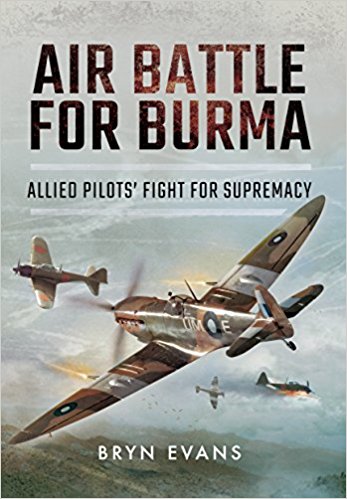Bryn Evans is an Australian author and management consultant that writes extensively across a wide range of categories, including military history, travel, and business management.
This book is a ‘must read’ for those who are aircraft enthusiasts, serious historians, or just devotees of a great adventure story. The most dramatic scenes are the personalised accounts of Commonwealth pilots, some flying perhaps the most iconic combat plane in history, the Spitfire, as they engage with the best fighters of the Japanese Army Air Force over Burma.

Hardback 251pp RRP: $44.95
The purpose of book is to paint a picture of the role which airpower played during the three-and-a-half-year campaign of fighting across Burma from early 1942 to August 1945, and the publication achieves this admirably. The Japanese Imperial Forces dominated the first six months of the campaign, where they continually generally out-thought and out-fought the Commonwealth military. Much of this was due to their dominant air power, which played major roles in the sinking of HMS Prince of Wales and Repulse in December 1941; as reconnaissance leading up to the destruction of an Allied fleet off Java in February 1942; and as a carrier-based strike force attacking Ceylon in April 1942. Burma itself was invaded by Japanese ground and air forces in February 1942, and largely occupied by the end of May. The purpose of this invasion was primarily to both disrupt American supplies into China for Nationalist forces fighting the Japanese, and then to act as a springboard for potential later invasion of British India.
Evans importantly highlights the geographical and climatic conditions across Burma, which largely determined combat ground and air operations. There was a continued commitment by the Americans to support the Chinese Nationalist forces, and this required ferrying supplies over ‘the Hump’, mountainous ridges 14-16,000‘high, from India into Kunming, China. The terrain adjoining India and Burma, which was the main location of the ground fighting, was almost as equally challenging, comprising mountainous and hilly tracts, densely covered by thick jungle. Then of course there was the monsoon. This lasted annually from May to September, when the pervasive rainfall and flooding largely curtailed military operations, both on the ground and in the air.
Much of the ground fighting therefore takes place in the October – May periods, and Evans cleverly and succinctly weaves his story over four of these annual seasons. The 1941/42 period was of utterly dominated by the Japanese; whilst the 1942/43 campaign was one of ultimate stalemate, where neither side gained an ascendancy over the other. The 1943/44 campaign was more dramatic, where the Japanese encirclement of Commonwealth forces at ‘Admin Box’, Imphal and Kohima was largely broken by Allied airpower, which led to ultimate Japanese defeat in these locations. At each of the beleaguered garrisons, transport planes ferried in, or dropped, essential supplies, but they were only able to successfully achieve this due to Allied fighter planes gaining increasing ascendancy over their Japanese counterparts. Equally important roles were played by Allied fighter bombers and longer-range bombers, which together disrupted enemy troops and their supply lines, with increasingly devastating and demoralising results. The final act of the campaign was played out in 1944/45, where the ultimate aim of the Allied Forces, spearheaded by General Slim’s Fourteenth (XIV) Army thrusting down through the centre of Burma, was to occupy Rangoon by May, before the onset of the next monsoon season. That the Allies could achieve this was due to a combination of successful ground and amphibious campaigns, combined with a complete and comprehensive dominance by the Commonwealth and American air forces.
As well as some clear maps and striking photographs, what makes the book really ‘come alive’ is the interweaving of the personalised stories from some of the pilots themselves. Using a mixture of diaries and personal interviews, Evans includes these dramatic descriptions of combat between Commonwealth fighter pilots and their Japanese foes.
The Burma campaign has often been associated with the ‘Forgotten’ XIV Army. This is therefore an important contribution by Evans to shed some new light into this important, but somewhat underreported and undervalued, campaign.
Reviewed for RUSIV by Chris Piper*, April 2017
*Chris Piper is an international development consultant, living in Australia, whose father flew in one of the RAF squadrons mentioned in the story.
Air Battle for Burma (page 9)
Copies of Air Battle for Burma are available from the author Bryn Evans at bryn.evans@ozemail.com.au Air Battle for Burma (Nov 2016) $34.95, – Pen & Sword Books UK, Amazon etc. Signed First Editions available on request by email to Bryn Evans.
Contact Royal United Services Institute about this article.






